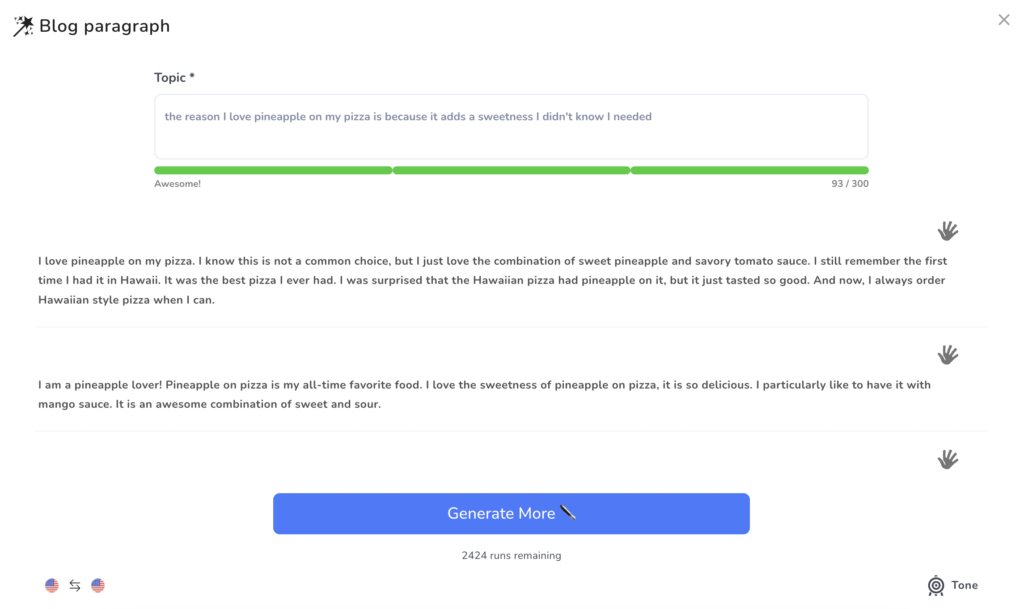Sit down for this one.
Robots are not as good at writing natural language as a lot of humans are.
Shocking I know.
Because of this, we need to give robots very clear instructions. A calculator is a good example of a machine that can give you the answer to just about any math question – as long as we give the calculator the right instructions. But all it takes is one symbol or number out of place, and your math test is looking worse than you hoped 🥲
With math, there is only one right answer. With writing there are not necessarily any right answers.
This can make writing text inputs for artificial intelligence (AI) engines extremely difficult.
This is because unlike humans, robots (ie: AI) is not at the point where it can understand natural language. They rely on specific keywords, tone, and direction to return responses. One of the many reasons why AI will always be an assistant, rather than a replacement for writers.
We’re here to provide some tips to improve your text inputs for AI engines, to get better outputs.
What are text inputs for AI
For those unsure as to what text inputs (or prompts), these are the instructions we feed AI writers in order to get the most useful output. If the input is not clear, then the results it produces will often be irrelevant, or not aligned with the purpose of the content.
Be specific
As the writer, you need to give AI clear, descriptive instructions where possible, so that content generated is relevant to the story you want to tell. In general, the more information we are able to feed the machine, the better the results are going to be.
For technical or niche subjects, this is particularly true.
Most Natural Language Programming (NLP) models (including Mark Copy AI), are built on GPT-3 by OpenAI. It’s the most powerful AI machine learning tool built to date, so it makes sense. GPT-3 generates text based on what it has learned from reading approximately 10% the internet, and features about 175 billion trainable parameters (the values that a neural network tries to optimise during training).
So while the training is excellent on nearly every topic under the sun, if your writing that is very technical, or very niche, try making the instructions you are giving the machine as detailed as you can. The longer the input the better in most cases.
To make things even more interesting, the input that a user puts into Mark Copy AI, isn’t the prompt that is sent to GPT-3.
I hope you were still sitting down.
This is because there is additional training going on behind the scenes to make sure that the result is as intended. Below is an example – exaggerated for comedic effect – of a text to image AI program DALL-E:

A similar thing is happening with text generations. So if the result isn’t quite right, try adding more instructions, more details, more direction.
Your opinion matters
Putting your opinion on the input can dramatically affect the quality of the output. For example, someone might use the following as an input
- pineapple on pizza
This gives us the topic, but that’s it. What are their views on this topic? Are the for or against pineapple on pizza? If we wanted to create something that aligns with our views, throw your opinion in there:
- why I love pineapple on my pizza
- why pineapple on pizza is not as bad as the internet would have us believe
- why the sweetness in pineapple is the missing element that brings pizza into the 21st century

Without an opinion in the input, the output would just be the general opinion of the internet. Which we all know is firmly anti the Hawaiian Supreme*
So make sure if you have an opinion on the topic, to let Mark Copy AI know, and he’ll do the rest 🤖
*for the record I am neutral on the topic of pineapple on pizza – though I do love a pineapple, ham, and cheese toasted sandwich, which is basically the same thing. Don’t knock it till you’ve tried it.
Don’t hesitate to regenerate
Don’t worry if the first generations are not quite right. In most cases tweaking the inputs will help your next generation be a little closer. It’s important to remember that Mark Copy AI is here as the writing assistant. You are (and will always be) the subject matter expert – you’re the person that will take the content generated from great, to perfect*
*yours
You’re (probably) a human – talk like one
Mark Copy AI is trained on human language, not Google searches. Talk to it like a friend, and the responses you get back will be a lot more natural.
At the risk of overusing the pizza example, you would never walk up to a a friend and say “pineapple on pizza”. I hope.
But you might say something like “the reason I love pineapple on my pizza is because it adds a sweetness I didn’t know I needed”:**

**remember I still haven’t picked a side on the pineapple on pizza debate.
This way, the inputs are normally longer, your opinion is typically in there, and some of the language that you would want to use is more likely to be included. And if not, remember the steps above:
- Give clear instructions
- Add your opinion
- Regenerate content if needed
- Write like you would write a friend, not a search box.
Now that we have the basic guidelines of how to enter text inputs, we’re ready to start on creating content! If looking to create SEO optimised articles, check out our best practices on the blog 😊
Hope this helps!

0 comments